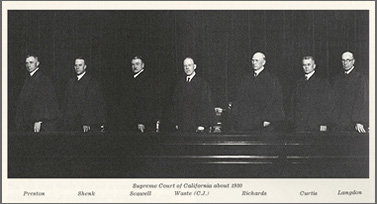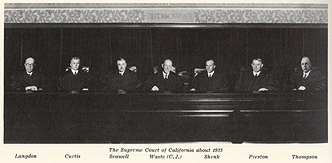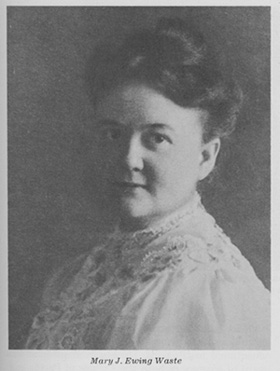Chief Justice William
Harrison Waste, Part 2
|
"During his seven years of higher
education, Waste had made his home in Berkeley, earning much
of his way working for local newspapers. He began practicing
law in Berkeley, later moving his office to Oakland. His first
retainer was a silver dollar which he promptly spent as he needed
the money. Waste later said he had wished a hundred times he
had kept that first dollar earned as an attorney. In 1896 and
1897 he had a partner, John W. Stetson, but in 1898 he returned
to practicing alone.
The young lawyer engaged immediately
in politics and civic activities. He participated in the founding
of the Berkeley Public Library, becoming its first president.
He assisted in founding the Epworth University Methodist Church,
taking an active part in its leadership for the rest of his life.
The fact that Waste was not a man of short-lived enthusiasms
is borne out by his thirty-seven years' service as president
of the Berkeley Y.M.C.A., which he also helped found.
Waste was elected an Asemblyman in
1902 and 1904, serving the thirty-fifth and thirty-sixth session
of the Legislature, which enacted the first juvenile court laws
in the United States, introduced probation for adult offenders,
regulated party primary elections, prohibited sale of liquor
near public schools, regulated child labor and passed a compulsory
education law.
After practicing law just over ten
years, Waste was appointed by Governor Pardee to the Superior
Court in Alameda County on April 13, 1905. He remained on the
bench the remaining thirty-five years of his life, fourteen of
them on the Superior Court.
In January, 1919, he was appointed
the Presiding Justice of the District Court of Appeal, First
District, by Governor Wiliam D. Stephens, succeeding Thomas J.
Lennon who had been elevated to the State Supreme Court. His
associates on this court, Frank H. Kerrigan and John E. Richards,
both later becoming Supreme Court Justices.
Nearly three years later when Angellotti
resigned as Chief Justice, Governor Stephens in November, 1921,
appointed Shaw Chief Justice, and Waste to take Shaw's place
as an Associate Justice. The other Associate Justices at that
time were Lawlor, Wilbur, Lennon, Sloane and Shurtleff. Waste
served as an Associate Justice five years under Chief Justices
Shaw, Wilbur and Myers. |
Chief Justice of
the California Supreme Court
 |
|
The California Supreme
Court around 1930
(click on the image for larger
version) |
|
In January, 1926, upon the resignation
of Myers, Waste was appointed Chief Justice by his friend of
many years, Governor Friend W. Richardson. His fourteen years
as Chief Justice have been exceeded in length only by Beatty
and Gibson.
Several of Waste's predecessors resigned
from the Court to get in on the higher emoluments of private
practice. Waste apparently had no urge to follow in this tradition,
preferring judicial labors.
Waste believed that the courts should
be close to the people. A Supreme Court clerk said Waste was
easier to talk to than half of the lawyers who came in the office. |
 |
|
The California Supreme
Court around 1933
(click on the image for larger
version) |
|
Waste became a proficient presiding
officer. A fluent speaker with a gift of sensing that which was
appropriate to the occasion, he displayed fine authority whether
presiding over the Supreme Court, wielding the gavel as president
of the Commonwealth Club, or greeting strangers at the door of
his church. He was dignified without any airs. Reference to him
by the friends of the years as "Bill", "Will",
or "Billy", never suggested taking liberties. In his
later years it was not uncommon to see him in sweater and slacks
as he watered the lawn of his Spruce Street home at the end of
the day, and graciously nodded to the "Hi, Judge" from
the paper boy passing on his bicycle. This characterized Waste's
genuine interest in youth. An associate once remarked that Waste's
favorite judicial duty was the admitting of young men to the
practice of law. |
My great-grandmother
Mary Ewing Waste
 |
|
Mary J. Ewing, my great-grandmother |
|
Two years after receiving his law
degree, Waste married Mary J. Ewing, of an old Virginia family
from Lee County. They had two children, William E. and Eugenia
McIntosh (Mrs. Jean Ward). Mrs. Waste died in 1927.
William E. Waste, a construction
executive, had a hand in many important construction and industrial
projects, including the building of Boulder (Hoover) Dam, and
supervising a World War II shipyard in Marin County. He was the
Executive Vice-President of the Bechtel Corporation in San Francisco.
Like his father, he engaged in many fraternal and community service
projects. In 1937, Waste, a past-grand commander of California
Knights Templar, installed his son as Commander of the Berkeley
Commandery.
In 1932, Waste married Lucille Miller
Scoonover, a native of Belton, Texas, widow of Frank M. Scoonover,
a Berkeley businessman. She died February 20, 1941, surviving
Waste by only eight months." |
|